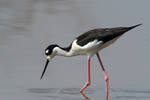 The Brazilian Pantanal is the largest wetland area and one of the focal points of the bird life in South America. The water- rich region covers almost the size of the old federal states (230,000 km ²) and is not only home to many water birds, but also for many other representatives of the tropical to temperate latitudes. More than 600 species of birds – almost a third of the avifauna of Brazil – have been detected there by 2011, of which approximately 20 % appear as migrants only seasonally. Among them are those from other Neotropical regions, but also from North America (Nearctic) and from the Pacific region (Australis) .
The Brazilian Pantanal is the largest wetland area and one of the focal points of the bird life in South America. The water- rich region covers almost the size of the old federal states (230,000 km ²) and is not only home to many water birds, but also for many other representatives of the tropical to temperate latitudes. More than 600 species of birds – almost a third of the avifauna of Brazil – have been detected there by 2011, of which approximately 20 % appear as migrants only seasonally. Among them are those from other Neotropical regions, but also from North America (Nearctic) and from the Pacific region (Australis) .
Although the origin of migratory species in most cases is known, but knowledge on fundamental facts such as distribution patterns, feeding ecology and ecological niches, bioacoustics and metabolic physiology (e.g. moult, fat assimilation) is still scarce. For example, in the Pantanal winter so heterogeneous migrants like Pacific waders or North American songbirds. Similar knowledge gaps exist for many of the native species, which consist of a variety of environmental (foraging) groups. A further focus of our studies is on rare and endangered bird species (incl. raptors; photo: Harpy Eagle, © J. Ferdinand). According to international criteria of the International Union for the Conservation of Nature (IUCN), 28 species are considered endangered, including e.g. Penelope ochrogaster, Harpyhaliaetus coronatus, Columbina cyanopis, Synallaxis simoni and Alectrurus tricolor. As a prime example, the almost exclusively Pantanal-restricted Hyacinth Macaw (Anodorhynchus hyacinthinus; photo: © L. Möcklinghoff) needs to be mentioned; its almost extinct population (by end of the last century in the core area has now grown back to about 5,000 individuals.
Methodology and project objectives
The growing threat to the ecosystem Pantanal by human intervention will proceed ahead in the future. Due to already affecting agricultural confounding factors on the one hand (fertilizer entry, melioration, conversion to cropland and pastures) and the construction of huge hydropower plants on the other hand, large areas of wetland will be inevitably destroyed and lost for ever. Following a massive lowering of the groundwater level in the coming decades, transformation of today’s species-rich wetland countries over a large area into dry areas with only a few generalist species must be expected. Projects for the protection of animal and plant life therefore have the highest priority to a critical impetus to the progressive loss of biodiversity in the coming years. At the invitation of the Brazilian National Wetland Institute (INAU), the Brehm Fund will therefore contribute to an international cooperation project of the University of Cuiaba to monitor the zoological diversity of the Pantanal and exclusively carry out ornithological studies on the biology and distribution of water and migratory birds .
In the focus of the Brehm Fund project will be the collection of data on the occurrence and distribution patterns of bird species in the northern Pantanal using traditional and novel monitoring methods. Modern recording techniques, such as automatic sound recording and camera traps will be used. In addition to monitoring, trapping with special mistnets and audiovisual monitoring within selected transects at additional stations will automatically register bio-acoustic utterances and movements using appropriate receiver and transmitter equipment (microphones, camera traps) and forward these data for further evaluation by specific software on computer base stations. The measuring and control stations are both natural (cerrado savannah, gallery forests, marshland) and human-affeted (willows) habitat types, and their vegetation structures will be recorded and characterized. In addition, a sound archive is to be established with the voices of birds in the region.
This research approach will finally help to answer important questions, such as the composition and the seasonal interactions of resident and migratory bird species, and the selected groups of birds as indicators of medium-and long-term changes in the ecosystem:
- Which species, groups of species or biodiversity indices represent the best indicators of (seasonal) changes in vegetation cover, land use, and climatic factors ?
- How about the niching of long-and short-distance migrants in comparison with the resident water birds?
- What number of monitoring stations is best suited per study area (cost -effectiveness optimization) ?
- How accurate and reliable are the data collected by the automatic measuring stations over conventional monitoring methods (network capture, audio-visual proof) ?
- How do bird communities change with the implementation of new land management measures at habitat transitions (gradual vs. abruptly) or the restoration of habitat corridors) ?
Using the answers land use strategies should be explored, i.e. how bird communities are affected by changes in local climatic and ecological conditions and the cyclical rise and fall in the water level along the studied landscape gradients.
To purchase technical equipment for field studies the Brehm Fund will invest € 30,000. In our newsletters we will report in detail on the progress of the investigations.

